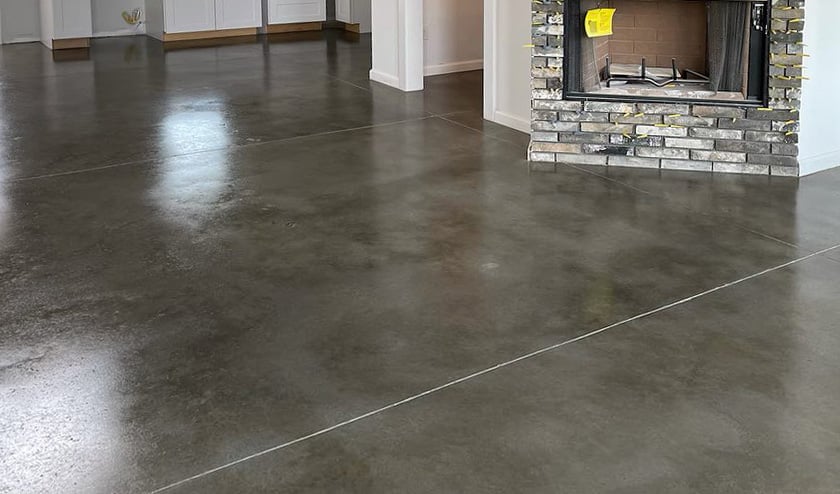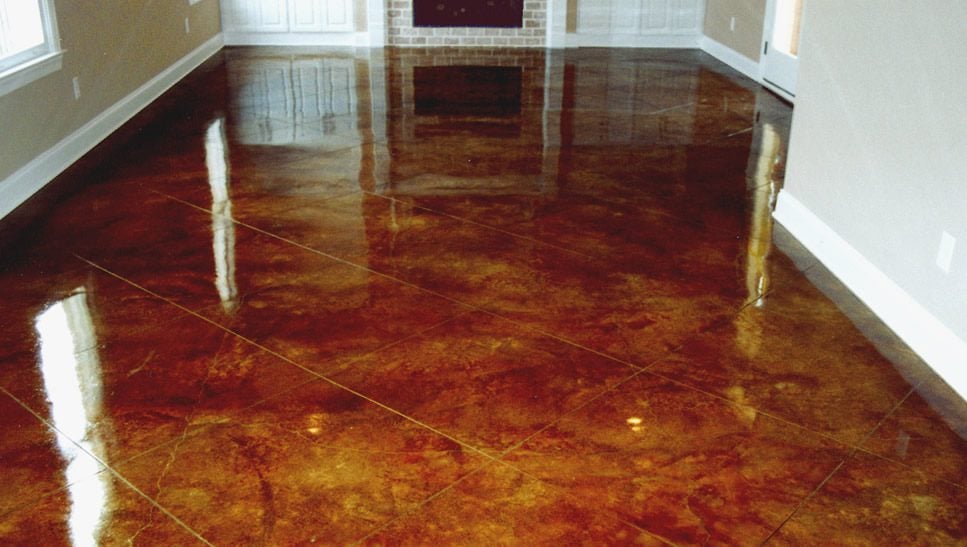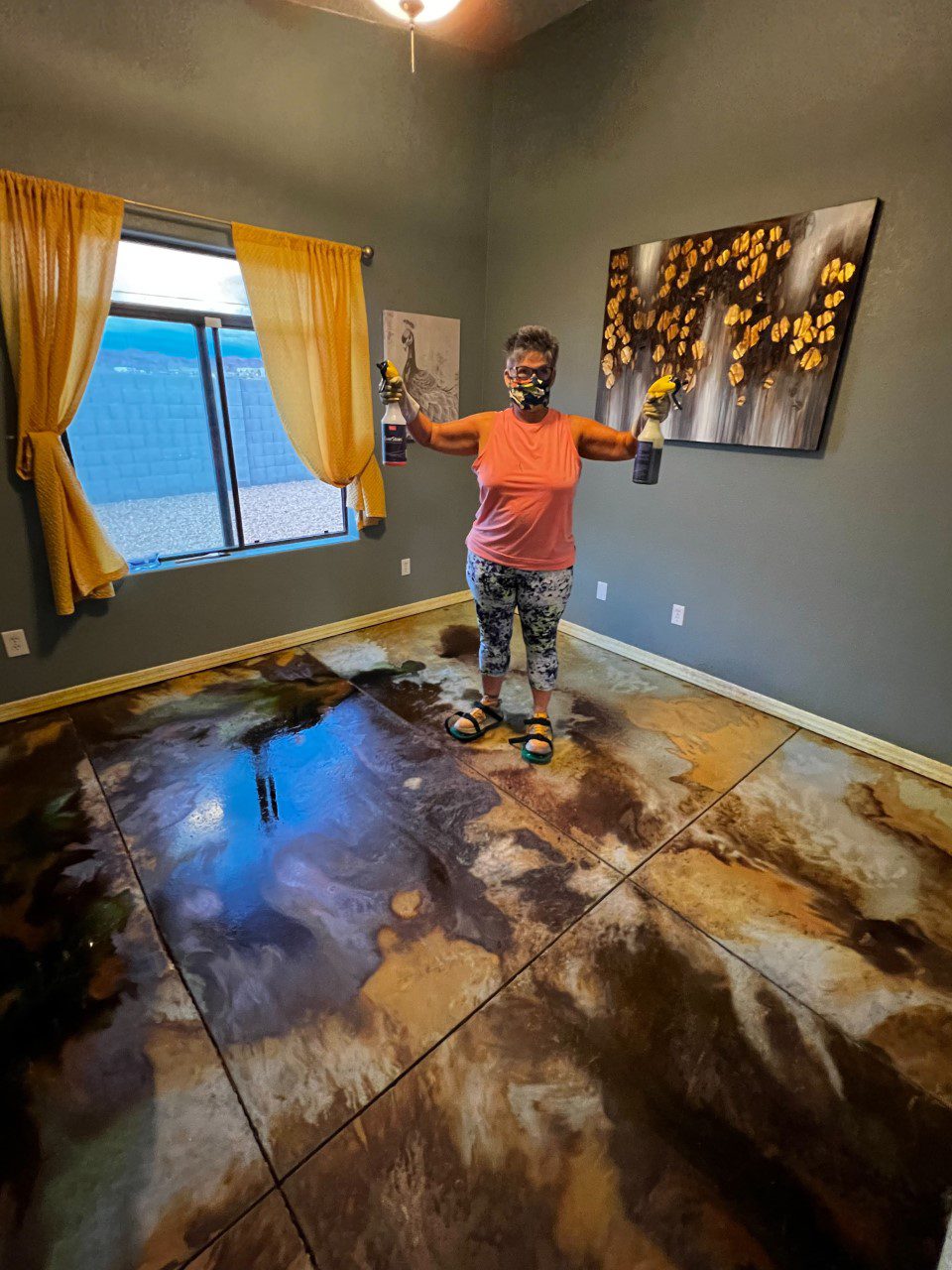Everything About Stained Concrete: A Comprehensive Guide to Its Benefits and Applications
Stained concrete has arised as a prominent selection for both residential and industrial rooms. Its ability to integrate aesthetic charm with practicality makes it an intriguing choice. Different discoloration strategies use a series of shades and surfaces, enabling for customization. The benefits expand beyond appearance. Recognizing its applications and upkeep needs is vital for anyone considering this functional material. The subtleties of stained concrete invite better expedition.
What Is Stained Concrete?

Discoloration can be put on various surfaces, including floorings, driveways, and patios, making it a versatile alternative for both interior and outside rooms. The therapy can achieve a series of looks, from earthy tones to strong, contemporary styles. Unlike paint, stained concrete maintains its appearance over time, as it comes to be an important part of the concrete itself. In general, stained concrete serves as an effective technique for transforming regular concrete right into visually striking surface areas.
Advantages of Stained Concrete
Stained concrete offers significant advantages, specifically in aesthetic allure and sturdiness - Austin Stained Concrete Floors. Its dynamic colors and distinct patterns boost the visual beauty of any type of area, making it a popular choice for both property and commercial applications. Additionally, the durability of stained concrete warranties that it stays a practical financial investment with time, withstanding wear and tear
Visual Appeal
One of one of the most engaging advantages of using stained concrete is its impressive visual appeal. Stained concrete offers an unique and flexible appearance that can match various style styles, from modern-day to rustic. The mixture of lively colors and elaborate patterns permits home owners and designers to develop customized surface areas that can enhance the general atmosphere of a space. Unlike standard floor covering choices, stained concrete can resemble the appearance of all-natural rock or polished marble, supplying a high end look without the linked costs. Furthermore, the glossy finish alternatives can reflect light, additional brightening insides. This versatility makes stained concrete a popular option for both residential and industrial applications, where aesthetic impact is vital.
Toughness and Longevity
The outstanding visual top qualities of stained concrete are enhanced by its remarkable toughness and long life - Austin Stained Concrete Floors. Stained concrete surfaces are resistant to deterioration, making them ideal for high-traffic locations both inside your home and outdoors. Their robust nature indicates they can hold up against severe weather, consisting of severe temperatures, rain, and UV exposure, without considerable deterioration. Furthermore, stained concrete requires minimal upkeep compared to various other flooring choices, as it does not need frequent sealing or redecorating. This durability not only lowers substitute expenses but also adds to a sustainable building method. Overall, stained concrete provides a long-lasting remedy that incorporates aesthetic charm with useful benefits, guaranteeing its worth gradually
Different Kinds Of Staining Strategies
Various staining strategies can significantly affect the aesthetic top qualities of concrete surface areas. The three key approaches consist of acid staining, which responds chemically with the concrete, water-based discoloration, which supplies a wider variety of shades, and overlay staining alternatives that give a fresh surface. Each strategy has special qualities and applications that deal with different design preferences and task demands.
Acid Discoloration Technique
How can property owners change plain concrete surfaces right into visually striking functions? One reliable method is acid discoloration, a popular strategy that enhances the natural beauty of concrete. This procedure involves applying a solution of water, hydrochloric acid, and metallic salts to the concrete surface area. As the acid responds with the lime present in the concrete, it produces abundant, variegated shades that look like marble or rock. Acid staining is understood for its sturdiness and resistance to fading, making it a long-lasting choice for both interior and exterior applications. However, it is vital to keep in mind that the results can vary based on the original concrete shade and appearance - Stained Concrete Austin. Appropriate application and sealing are crucial for accomplishing the wanted visual and long life
Water-Based Discoloration Strategy
A preferred alternative to acid discoloration, the water-based discoloration method uses home owners a functional means to boost concrete surface areas. This approach uses water-soluble dyes and pigments, permitting a vast array of colors and coatings. Unlike acid discolorations, water-based discolorations can be put on unsealed concrete and use a much easier clean-up process. The results can attain an extra consistent appearance and can be layered to create distinct effects. In addition, water-based discolorations are usually much less harmful and discharge less unstable organic compounds (VOCs), making them extra eco friendly. Property owners may appreciate the ability to customize their concrete surface areas with different shades, permitting for creative expression while keeping longevity and durability in their flooring options.
Overlay Staining Options
Countless overlay discoloration options exist for home owners looking to renew their concrete surface areas. One preferred option is acid discoloration, which reacts chemically with the concrete to produce rich, variegated shades. An additional alternative is water-based discoloration, providing a wider shade scheme and easier application. Additionally, concrete overlays can be integrated with patterns for complex layouts, enhancing appearances. For a more textured finish, property owners may think about making use of stamped overlays that resemble all-natural materials like stone or floor tile. Each strategy gives one-of-a-kind advantages, from resilience to personalization, permitting for a tailored touch. Ultimately, the choice of overlay staining depends on the wanted look and the condition of the existing concrete, guaranteeing a revitalized and appealing surface.
Applications of Stained Concrete
Stained concrete deals a flexible service for different applications, enhancing both aesthetic allure and capability. This product is commonly made use of in domestic, commercial, and commercial setups, making it a preferred choice among designers his response and designers. In homes, stained concrete can offer as fashionable floor covering or exterior patios, giving an innovative look while continuing to be sturdy.
In industrial spaces, such as stores and restaurants, stained concrete contributes to a contemporary ambiance and can withstand hefty foot traffic. In addition, stained concrete is increasingly used in public areas like parks and walkways, where its capability to imitate all-natural stone or various other materials adds aesthetic interest.
Furthermore, stained concrete is ideal for swimming pool decks and driveways, offering a slip-resistant surface that is very easy to maintain. Overall, the adaptability of stained concrete makes it ideal for various environments, providing to varied tastes and needs.
Upkeep and Look After Stained Concrete
Proper maintenance guarantees the durability and appeal of stained concrete surface areas. Normal cleansing is essential; using a moderate detergent and water with a soft-bristle brush assists eliminate dirt and gunk without harming the surface. It is a good idea to prevent rough chemicals that can remove away the tarnish or sealer.
Securing stained concrete is crucial for defense versus wetness, spots, and use. A high-quality sealant should be reapplied every one to three years, relying on the traffic and direct exposure the surface area sustains. In addition, resolving spills without delay will protect against discoloration and discoloration.

Cost Factors To Consider for Stained Concrete Projects
When planning a tarnished concrete project, spending plan factors to consider play a vital role in figuring out the total expense. The expenses linked with stained concrete can vary considerably based upon numerous factors. The size of the location to be stained directly affects material and labor costs. Larger areas will normally call for more resources. Second, the kind of discolor selected-- acid-based or water-based-- can affect pricing, with acid spots frequently being much more pricey. In addition, the complexity of the design, consisting of index patterns or numerous shades, can Recommended Site enhance labor prices. Preparation job, such as cleansing and grinding the concrete surface, adds to the initial costs too. The option in between DIY installment and employing an expert specialist will even more impact the budget plan. Understanding these variables allows homeowners to make informed economic decisions concerning their stained concrete jobs, ensuring they attain the preferred visual within their monetary ways.
Tips for Choosing the Right Stained Concrete for Your Area
Choosing the appropriate stained concrete for a particular area includes cautious consideration of various elements past simply budget plan. One ought to evaluate the designated usage of the location. High-traffic zones might require even more long lasting surfaces, while decorative applications can focus on looks.
The shade combination is one more essential facet; the picked colors must balance with existing decoration and illumination. It's also important to take into account the surface area structure, as smooth finishes can enhance sophistication, while distinctive choices may guarantee safety and security in damp areas.
Local environment and ecological problems play a considerable role in the long life and maintenance of stained concrete, influencing the selection of sealers and finishes.
Ultimately, talking to experts can offer valuable understandings tailored to particular requirements, guaranteeing the option of the excellent stained concrete that lines up with both functionality and design.

Often Asked Questions
Can Stained Concrete Be Applied Over Existing Floor Covering?
Stained concrete can undoubtedly be applied over existing floor covering, offered the surface area is steady and properly prepared. This approach permits for an aesthetic upgrade without the demand for total elimination of the original floor covering materials.
The Length Of Time Does Stained Concrete Last?
Stained concrete can last for years when appropriately maintained. Elements such as website traffic, environmental conditions, and application techniques substantially affect its durability, with lots of setups continuing to be dynamic and undamaged for 10 to 30 years.
Is Stained Concrete Slippery When Wet?
Stained concrete can be unsafe when damp, as the finish may develop a smooth surface. Nevertheless, making use of non-slip additives or textured surfaces can minimize this issue, improving safety and security without endangering the aesthetic charm of the concrete.
Can I Stain Concrete Myself, or Should I Employ a Specialist?
The decision to tarnish concrete personally or hire an expert depend upon ability degree and job intricacy. While do it yourself discoloration can conserve cash, specialists assure optimal outcomes, specifically for detailed layouts or huge surfaces.
What Color styles Are Readily Available for Stained Concrete?
The selection of shades readily available for stained concrete consists of natural tones like browns and tans, lively tones such as reds and blues, and softer colors like pastels. This combination permits imaginative, tailored layout alternatives.